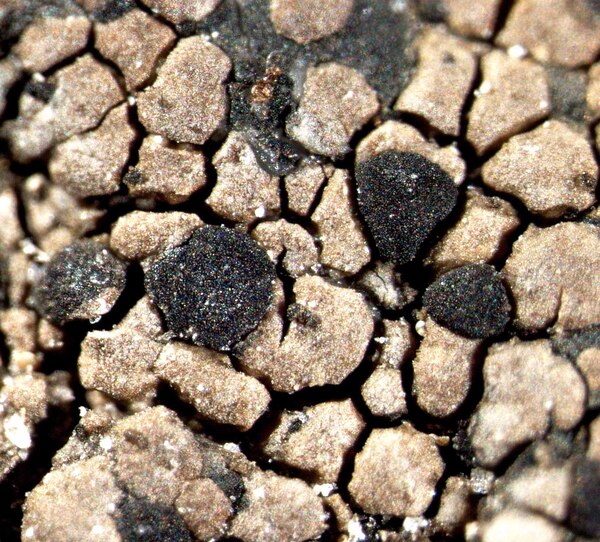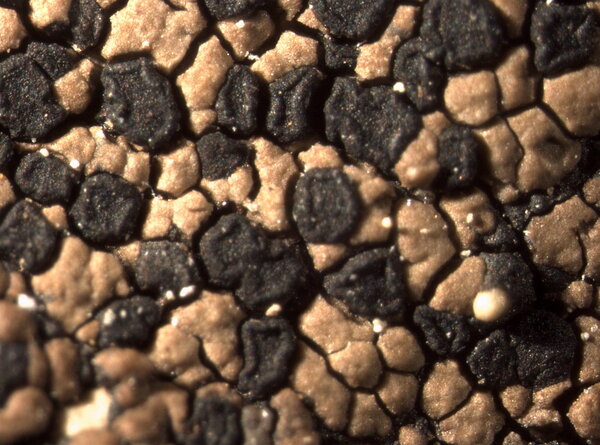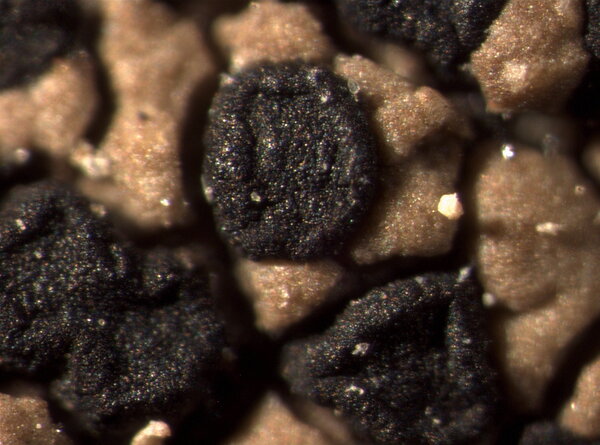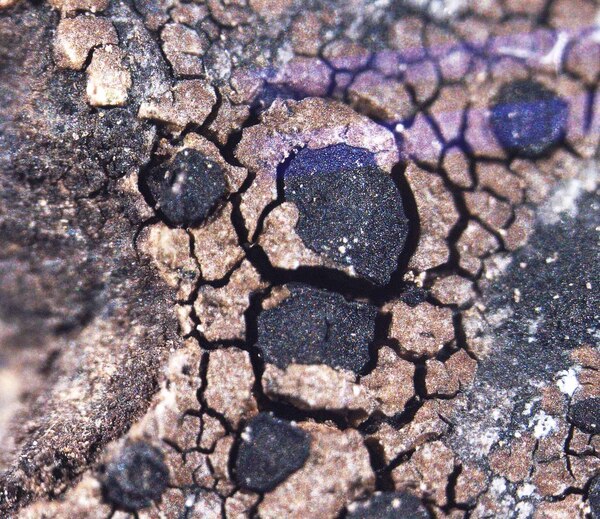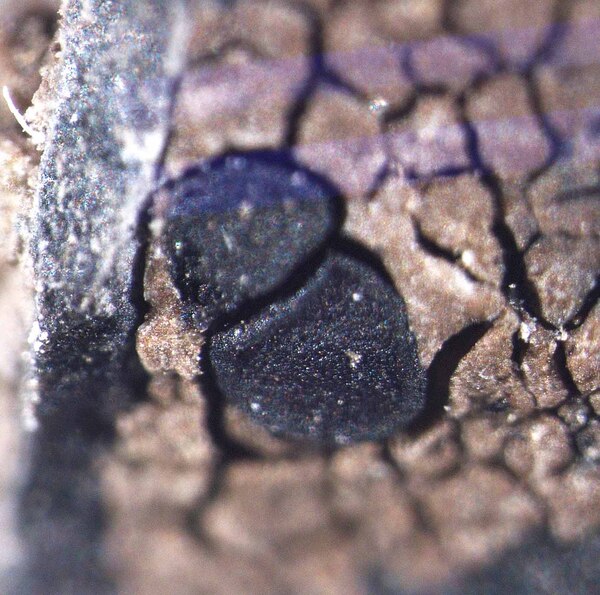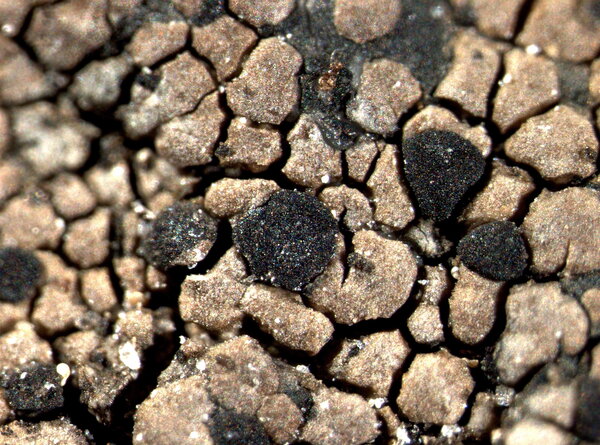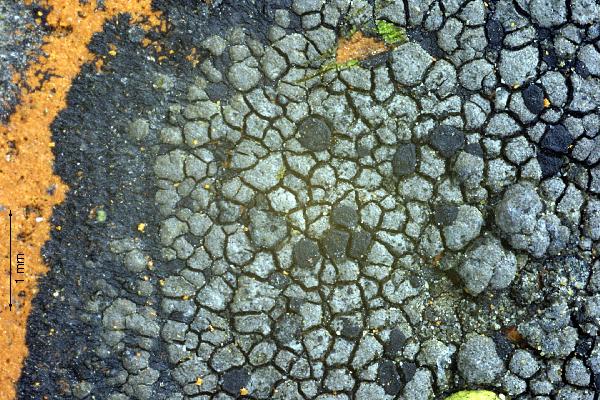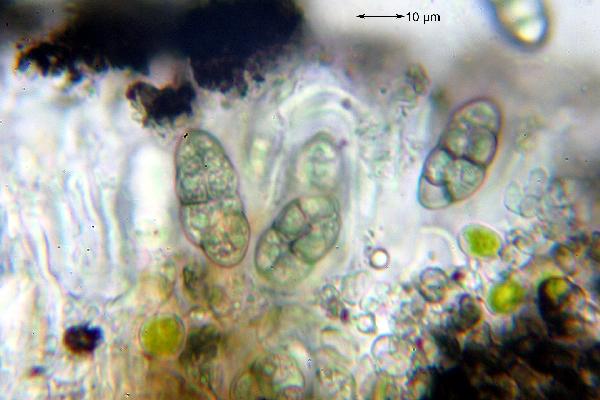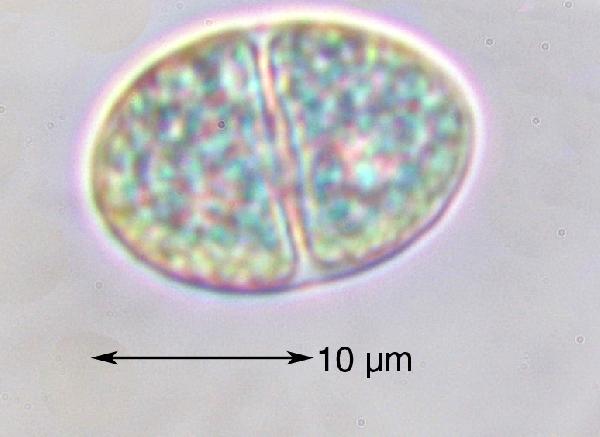Rhizocarpon polycarpum (Hepp) Th. Fr.
Lichenogr. Scand., 2: 617, 1874. Basionym: Lecidea confervoides var. polycarpa Hepp - Flecht. Eur.: nr. 35, 1853.
Synonyms: Buellia atroalbella (Nyl.) Mong. non auct.; Buellia umensis H. Magn.; Catocarpus dendriticus (Hoffm.) M. Choisy ex Werner; Catocarpus polycarpus ("Hepp") Arnold; Lecidea atroalbella (Nyl.) Nyl.; Lecidea atroalbicans Nyl.; Rhizocarpon confervoides sensu Rabenh. non A. Massal.; Rhizocarpon cyanescens (Hellb.) Zahlbr.
Distribution: N - Frl (Tretiach & Hafellner 2000), Ven, TAA (Nascimbene & al. 2022), Lomb, Piem (Isocrono & al. 2004, Morisi 2005, Isocrono & Piervittori 2008, Favero-Longo & al. 2015), VA (Piervittori & Isocrono 1999, Piervittori & al. 2001, 2004, Matteucci & al. 2015c). C - Tosc, Laz, Sar (Nöske 2000). S - Si (Grillo & Caniglia 2004).
Description: Thallus crustose, episubstratic, areolate, pale to dark grey-brown or violet-brown, forming up to 5(-8) cm wide patches which are often delimited by a black prothallus, the areoles developing on a black hypothallus, usually contiguous, angular or crescent-shaped around the apothecia, flat to convex, 0.3-0.8 mm wide. Medulla white, I+ deep blue. Apothecia lecideine, black, rounded to polygonal, sessile and slightly constricted at base, 0.4-0.8 mm across, with a flat to slightly convex, epruinose disc and a thin or inapparent proper margin. Proper exciple brown to brown-black in outer part, paler brown within, K+ red (solution); epithecium brown-black to violet-brown, K+ purple-red, rarely K-, without crystals; hymenium colourless or pale greenish in upper part, 70-100(-130) µm high; paraphysoids coherent, branched and anastomosing, c. 2 µm thick at mid-level, the apical cells 2-3 µm wide, with brownish-black tips; hypothecium dark brown, K-. Asci 8-spored, clavate, fissitunicate, with a well-developed tholus that is K/I- in lower part and K/I+ blue near the apex, lacking an ocular chamber, Rhizocarpon-type. Ascospores 1(-3) septate, hyaline or sometimes turning pale grey-brown when overmature, 17-27(-32) x 8-11(-14) µm, halonate. Spot tests: thallus K-, P-, KC-, P-; medulla K- or K+ pale yellow, C-, KC-, P- or P+ orange-yellow. Chemistry: medulla without lichen substances, more rarely with stictic acid.Note: a probably holarctic pioneer species found on siliceous pebbles over moist ground, or on steeply inclined faces near the ground, present at low altitudes only in humid areas.
Growth form: Crustose
Substrata: rocks
Photobiont: green algae other than Trentepohlia
Reproductive strategy: mainly sexual
Pioneer species
Commonnes-rarity: (info)
Alpine belt: rather rare
Subalpine belt: rather common
Oromediterranean belt: rather rare
Montane belt: rather rare
Submediterranean belt: very rare
Padanian area: absent
Humid submediterranean belt: very rare
Humid mediterranean belt: extremely rare
Dry mediterranean belt: absent
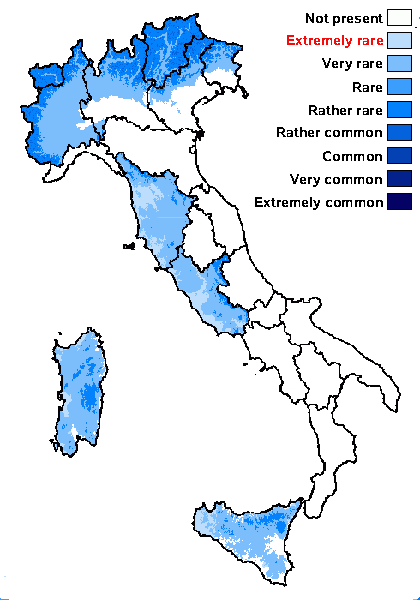
Predictive model
Herbarium samples
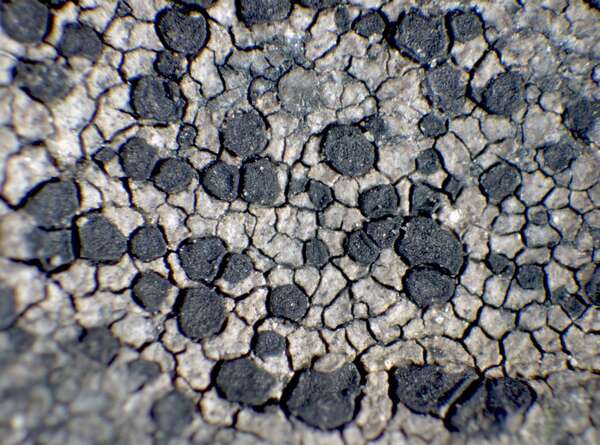

P.L. Nimis; Owner: Department of Life Sciences, University of Trieste
Herbarium: TSB (4499)
2001/12/01
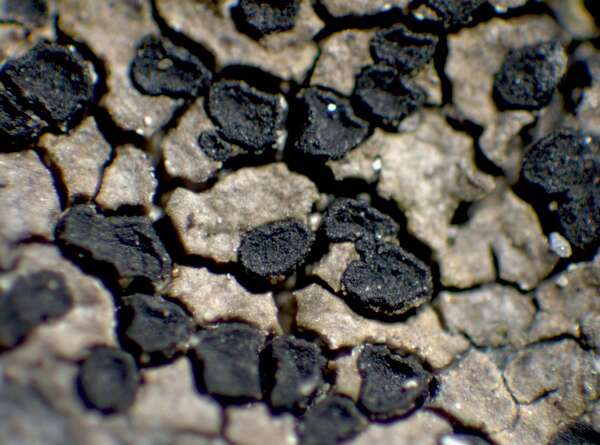

P.L. Nimis; Owner: Department of Life Sciences, University of Trieste
Herbarium: TSB (34432)
2001/12/01
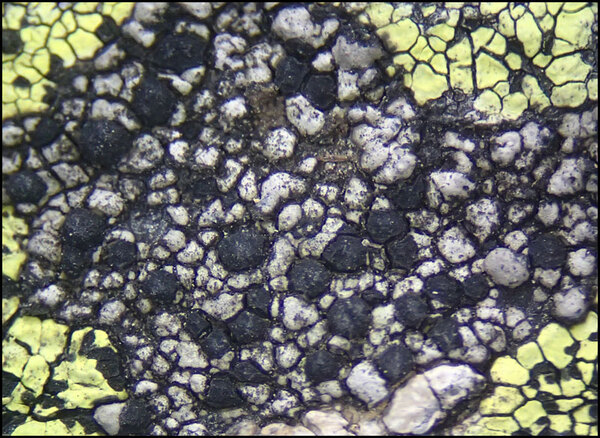
Courtesy Danièle et Olivier Gonnet - Source: https://www.afl-lichenologie.fr/Photos_AFL/Photos_AFL_R/Textes_R/Rhizocarpon_polycarpum.htm
France, 5/10/2015 - Valle-di-Rostino, pont de Muzille, alt. 161 m - Corse - (20) - (sur schistes lustrés)
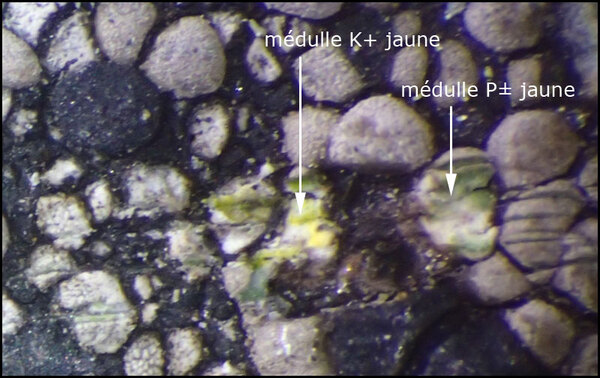
Courtesy Danièle et Olivier Gonnet - Source: https://www.afl-lichenologie.fr/Photos_AFL/Photos_AFL_R/Textes_R/Rhizocarpon_polycarpum.htm
France, 5/10/2015 - Valle-di-Rostino, pont de Muzille, alt. 161 m - Corse - (20) - (sur schistes lustrés)
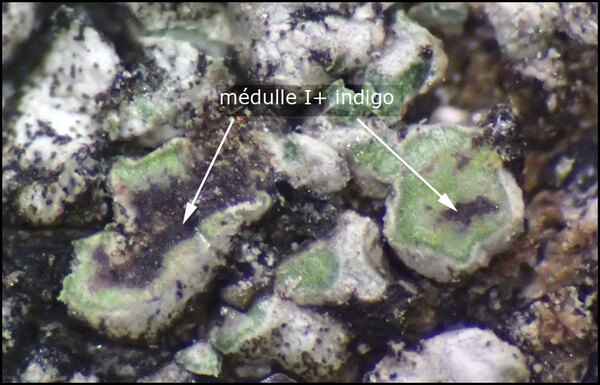
Courtesy Danièle et Olivier Gonnet - Source: https://www.afl-lichenologie.fr/Photos_AFL/Photos_AFL_R/Textes_R/Rhizocarpon_polycarpum.htm
France, 5/10/2015 - Valle-di-Rostino, pont de Muzille, alt. 161 m - Corse - (20) - (sur schistes lustrés)
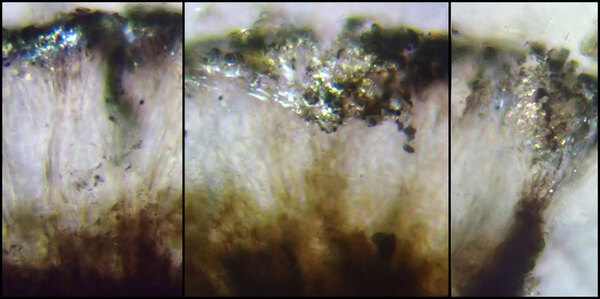
Courtesy Danièle et Olivier Gonnet - Source: https://www.afl-lichenologie.fr/Photos_AFL/Photos_AFL_R/Textes_R/Rhizocarpon_polycarpum.htm
France, 5/10/2015 - Valle-di-Rostino, pont de Muzille, alt. 161 m - Corse - (20) - (sur schistes lustrés)
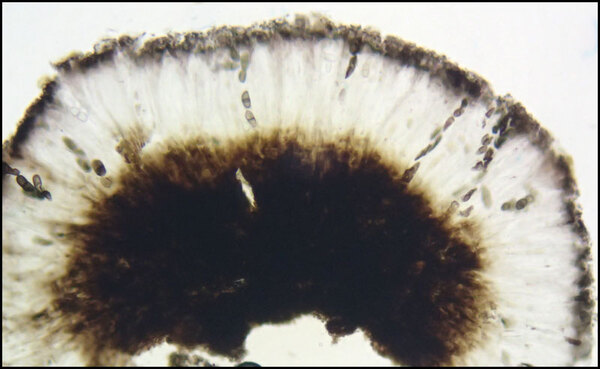
Courtesy Danièle et Olivier Gonnet - Source: https://www.afl-lichenologie.fr/Photos_AFL/Photos_AFL_R/Textes_R/Rhizocarpon_polycarpum.htm
France, 5/10/2015 - Valle-di-Rostino, pont de Muzille, alt. 161 m - Corse - (20) - (sur schistes lustrés)
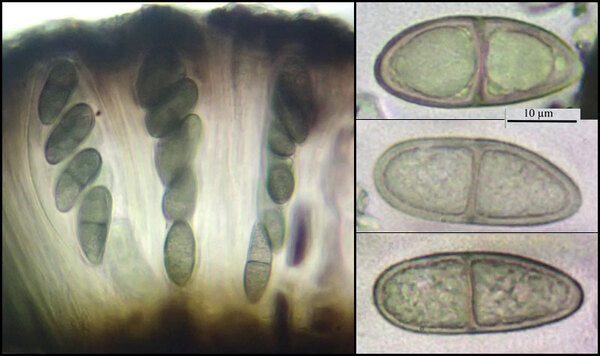
Courtesy Danièle et Olivier Gonnet - Source: https://www.afl-lichenologie.fr/Photos_AFL/Photos_AFL_R/Textes_R/Rhizocarpon_polycarpum.htm
France, 5/10/2015 - Valle-di-Rostino, pont de Muzille, alt. 161 m - Corse - (20) - (sur schistes lustrés)
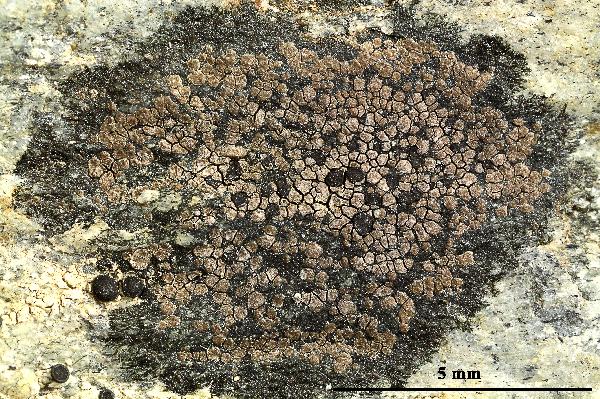

Felix Schumm - CC BY-SA 4.0
[20642], Österreich, Lungau, S-Seite des Großecks oberhalb Mauterndorf
in Richtung Speiereckhütte, 47.12846° N, 13.64913° E bis
47.13086° N, 13.64336° E, 1968 m - 2074 m, auf Silikatblock. Leg. F.
Schumm & U. Schwarz, 31.8.2019, det. F. Schumm. - Mark J+ blau.
Sporen braun, 1-septiert, ca. 20.5 x 9.1 μm, Epithecium braun, K- bis
rötlich.


Felix Schumm - CC BY-SA 4.0
[20642], Österreich, Lungau, S-Seite des Großecks oberhalb Mauterndorf
in Richtung Speiereckhütte, 47.12846° N, 13.64913° E bis
47.13086° N, 13.64336° E, 1968 m - 2074 m, auf Silikatblock. Leg. F.
Schumm & U. Schwarz, 31.8.2019, det. F. Schumm. - Mark J+ blau.
Sporen braun, 1-septiert, ca. 20.5 x 9.1 μm, Epithecium braun, K- bis
rötlich.
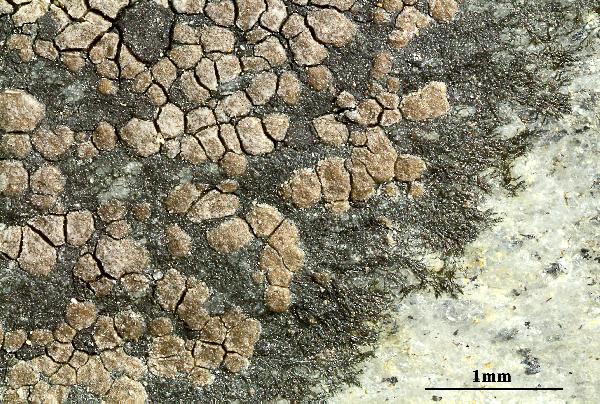

Felix Schumm - CC BY-SA 4.0
[20642], Österreich, Lungau, S-Seite des Großecks oberhalb Mauterndorf
in Richtung Speiereckhütte, 47.12846° N, 13.64913° E bis
47.13086° N, 13.64336° E, 1968 m - 2074 m, auf Silikatblock. Leg. F.
Schumm & U. Schwarz, 31.8.2019, det. F. Schumm. - Mark J+ blau.
Sporen braun, 1-septiert, ca. 20.5 x 9.1 μm, Epithecium braun, K- bis
rötlich.
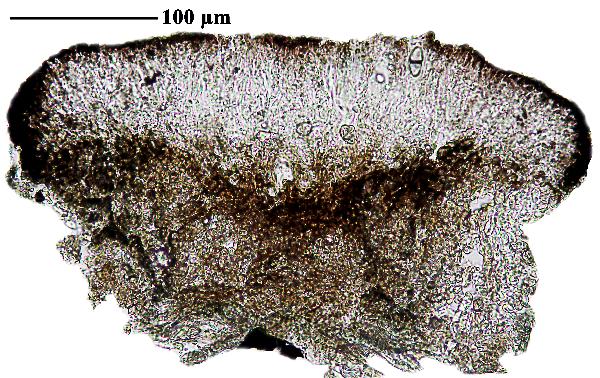

Felix Schumm - CC BY-SA 4.0
[20642], Österreich, Lungau, S-Seite des Großecks oberhalb Mauterndorf
in Richtung Speiereckhütte, 47.12846° N, 13.64913° E bis
47.13086° N, 13.64336° E, 1968 m - 2074 m, auf Silikatblock. Leg. F.
Schumm & U. Schwarz, 31.8.2019, det. F. Schumm. - Mark J+ blau.
Sporen braun, 1-septiert, ca. 20.5 x 9.1 μm, Epithecium braun, K- bis
rötlich.
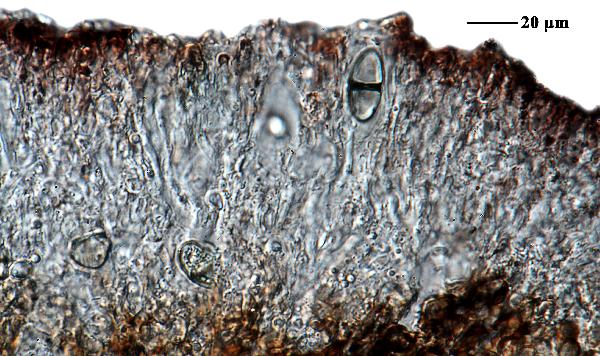

Felix Schumm - CC BY-SA 4.0
[20642], Österreich, Lungau, S-Seite des Großecks oberhalb Mauterndorf
in Richtung Speiereckhütte, 47.12846° N, 13.64913° E bis
47.13086° N, 13.64336° E, 1968 m - 2074 m, auf Silikatblock. Leg. F.
Schumm & U. Schwarz, 31.8.2019, det. F. Schumm. - Mark J+ blau.
Sporen braun, 1-septiert, ca. 20.5 x 9.1 μm, Epithecium braun, K- bis
rötlich.


Felix Schumm - CC BY-SA 4.0
[20642], Österreich, Lungau, S-Seite des Großecks oberhalb Mauterndorf
in Richtung Speiereckhütte, 47.12846° N, 13.64913° E bis
47.13086° N, 13.64336° E, 1968 m - 2074 m, auf Silikatblock. Leg. F.
Schumm & U. Schwarz, 31.8.2019, det. F. Schumm. - Mark J+ blau.
Sporen braun, 1-septiert, ca. 20.5 x 9.1 μm, Epithecium braun, K- bis
rötlich.
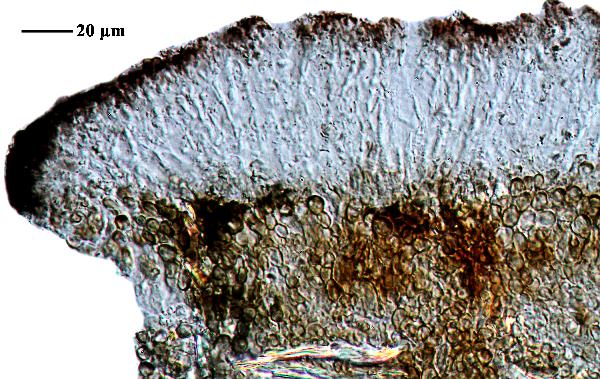

Felix Schumm - CC BY-SA 4.0
[20642], Österreich, Lungau, S-Seite des Großecks oberhalb Mauterndorf
in Richtung Speiereckhütte, 47.12846° N, 13.64913° E bis
47.13086° N, 13.64336° E, 1968 m - 2074 m, auf Silikatblock. Leg. F.
Schumm & U. Schwarz, 31.8.2019, det. F. Schumm. - Mark J+ blau.
Sporen braun, 1-septiert, ca. 20.5 x 9.1 μm, Epithecium braun, K- bis
rötlich.
Growth form: Crustose
Substrata: rocks
Photobiont: green algae other than Trentepohlia
Reproductive strategy: mainly sexual
Pioneer species
Commonnes-rarity: (info)
Alpine belt: rather rare
Subalpine belt: rather common
Oromediterranean belt: rather rare
Montane belt: rather rare
Submediterranean belt: very rare
Padanian area: absent
Humid submediterranean belt: very rare
Humid mediterranean belt: extremely rare
Dry mediterranean belt: absent

Predictive model
| Herbarium samples |


P.L. Nimis; Owner: Department of Life Sciences, University of Trieste
Herbarium: TSB (4499)
2001/12/01


P.L. Nimis; Owner: Department of Life Sciences, University of Trieste
Herbarium: TSB (34432)
2001/12/01

Courtesy Danièle et Olivier Gonnet - Source: https://www.afl-lichenologie.fr/Photos_AFL/Photos_AFL_R/Textes_R/Rhizocarpon_polycarpum.htm
France, 5/10/2015 - Valle-di-Rostino, pont de Muzille, alt. 161 m - Corse - (20) - (sur schistes lustrés)

Courtesy Danièle et Olivier Gonnet - Source: https://www.afl-lichenologie.fr/Photos_AFL/Photos_AFL_R/Textes_R/Rhizocarpon_polycarpum.htm
France, 5/10/2015 - Valle-di-Rostino, pont de Muzille, alt. 161 m - Corse - (20) - (sur schistes lustrés)

Courtesy Danièle et Olivier Gonnet - Source: https://www.afl-lichenologie.fr/Photos_AFL/Photos_AFL_R/Textes_R/Rhizocarpon_polycarpum.htm
France, 5/10/2015 - Valle-di-Rostino, pont de Muzille, alt. 161 m - Corse - (20) - (sur schistes lustrés)

Courtesy Danièle et Olivier Gonnet - Source: https://www.afl-lichenologie.fr/Photos_AFL/Photos_AFL_R/Textes_R/Rhizocarpon_polycarpum.htm
France, 5/10/2015 - Valle-di-Rostino, pont de Muzille, alt. 161 m - Corse - (20) - (sur schistes lustrés)

Courtesy Danièle et Olivier Gonnet - Source: https://www.afl-lichenologie.fr/Photos_AFL/Photos_AFL_R/Textes_R/Rhizocarpon_polycarpum.htm
France, 5/10/2015 - Valle-di-Rostino, pont de Muzille, alt. 161 m - Corse - (20) - (sur schistes lustrés)

Courtesy Danièle et Olivier Gonnet - Source: https://www.afl-lichenologie.fr/Photos_AFL/Photos_AFL_R/Textes_R/Rhizocarpon_polycarpum.htm
France, 5/10/2015 - Valle-di-Rostino, pont de Muzille, alt. 161 m - Corse - (20) - (sur schistes lustrés)


Felix Schumm - CC BY-SA 4.0
[20642], Österreich, Lungau, S-Seite des Großecks oberhalb Mauterndorf in Richtung Speiereckhütte, 47.12846° N, 13.64913° E bis 47.13086° N, 13.64336° E, 1968 m - 2074 m, auf Silikatblock. Leg. F. Schumm & U. Schwarz, 31.8.2019, det. F. Schumm. - Mark J+ blau. Sporen braun, 1-septiert, ca. 20.5 x 9.1 μm, Epithecium braun, K- bis rötlich.


Felix Schumm - CC BY-SA 4.0
[20642], Österreich, Lungau, S-Seite des Großecks oberhalb Mauterndorf in Richtung Speiereckhütte, 47.12846° N, 13.64913° E bis 47.13086° N, 13.64336° E, 1968 m - 2074 m, auf Silikatblock. Leg. F. Schumm & U. Schwarz, 31.8.2019, det. F. Schumm. - Mark J+ blau. Sporen braun, 1-septiert, ca. 20.5 x 9.1 μm, Epithecium braun, K- bis rötlich.


Felix Schumm - CC BY-SA 4.0
[20642], Österreich, Lungau, S-Seite des Großecks oberhalb Mauterndorf in Richtung Speiereckhütte, 47.12846° N, 13.64913° E bis 47.13086° N, 13.64336° E, 1968 m - 2074 m, auf Silikatblock. Leg. F. Schumm & U. Schwarz, 31.8.2019, det. F. Schumm. - Mark J+ blau. Sporen braun, 1-septiert, ca. 20.5 x 9.1 μm, Epithecium braun, K- bis rötlich.


Felix Schumm - CC BY-SA 4.0
[20642], Österreich, Lungau, S-Seite des Großecks oberhalb Mauterndorf in Richtung Speiereckhütte, 47.12846° N, 13.64913° E bis 47.13086° N, 13.64336° E, 1968 m - 2074 m, auf Silikatblock. Leg. F. Schumm & U. Schwarz, 31.8.2019, det. F. Schumm. - Mark J+ blau. Sporen braun, 1-septiert, ca. 20.5 x 9.1 μm, Epithecium braun, K- bis rötlich.


Felix Schumm - CC BY-SA 4.0
[20642], Österreich, Lungau, S-Seite des Großecks oberhalb Mauterndorf in Richtung Speiereckhütte, 47.12846° N, 13.64913° E bis 47.13086° N, 13.64336° E, 1968 m - 2074 m, auf Silikatblock. Leg. F. Schumm & U. Schwarz, 31.8.2019, det. F. Schumm. - Mark J+ blau. Sporen braun, 1-septiert, ca. 20.5 x 9.1 μm, Epithecium braun, K- bis rötlich.


Felix Schumm - CC BY-SA 4.0
[20642], Österreich, Lungau, S-Seite des Großecks oberhalb Mauterndorf in Richtung Speiereckhütte, 47.12846° N, 13.64913° E bis 47.13086° N, 13.64336° E, 1968 m - 2074 m, auf Silikatblock. Leg. F. Schumm & U. Schwarz, 31.8.2019, det. F. Schumm. - Mark J+ blau. Sporen braun, 1-septiert, ca. 20.5 x 9.1 μm, Epithecium braun, K- bis rötlich.


 INDEX FUNGORUM
INDEX FUNGORUM
 GBIF
GBIF
 DOLICHENS
DOLICHENS
